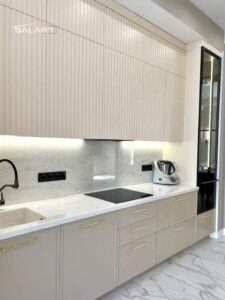Modern Stainless Steel Kitchen Cabinets 2024

In contemporary kitchen design, stainless steel has emerged as a top choice for cabinetry due to its sleek aesthetic and exceptional durability. Modern stainless steel kitchen cabinets not only add a touch of sophistication to your cooking space but also offer practical benefits that enhance functionality and longevity. This blog post will delve into everything you need to know about modern stainless steel kitchen cabinets, from their advantages and design ideas to maintenance tips and installation considerations.
Modern Stainless Steel Kitchen Cabinets
1. Why Choose Modern Stainless Steel Kitchen Cabinets?
Stainless steel kitchen cabinets have gained popularity for several reasons, making them a preferred choice for modern homeowners. Here’s why:
a) Durability and Longevity
Stainless steel is renowned for its strength and resilience. Unlike wood or laminate, it is resistant to warping, cracking, and fading. This durability ensures that your kitchen cabinets will maintain their appearance and functionality for years, even with daily use.
b) Easy Maintenance
One of the standout features of stainless steel is its ease of maintenance. The non-porous surface is resistant to stains, spills, and bacteria, making it simple to clean and sanitize. A quick wipe with a damp cloth is often all that’s needed to keep your cabinets looking pristine.
c) Modern Aesthetic
The sleek, shiny finish of stainless steel adds a contemporary and sophisticated look to any kitchen. Its reflective surface can make a space feel larger and brighter, contributing to a clean and modern design.
d) Hygienic Properties
The non-porous nature of stainless steel makes it highly hygienic. It doesn’t harbor bacteria or mold, which is particularly beneficial in a kitchen environment where cleanliness is crucial.
2. Design Ideas for Modern Stainless Steel Kitchen Cabinets
Modern stainless steel kitchen cabinets can be designed in various ways to suit different styles and preferences. Here are some design ideas to inspire you:
a) Minimalist Design
A minimalist approach focuses on simplicity and functionality. Stainless steel cabinets are perfect for this design philosophy due to their clean lines and smooth surfaces.
- Handle-less Doors: Opt for handle-less or push-to-open mechanisms for a sleek, seamless look.
- Flat-Front Cabinets: Choose flat-front panels for a streamlined appearance without visible hardware or embellishments.
b) Industrial Chic
Stainless steel cabinets fit perfectly with industrial-style kitchens, characterized by raw materials and an urban aesthetic.
- Exposed Elements: Emphasize the industrial look by showcasing exposed hinges and screws.
- Complementary Materials: Pair stainless steel with other industrial materials such as concrete, brick, or reclaimed wood to create a dynamic contrast.
c) High-Gloss Finish
For a high-end, glamorous look, consider high-gloss stainless steel cabinets.
- Reflective Surfaces: The glossy finish enhances light reflection, adding a touch of luxury and brightness to the kitchen.
- Accent Lighting: Incorporate LED lighting to highlight the gloss and add depth to the design.
d) Custom Configurations
Custom stainless steel cabinets offer flexibility to meet specific needs and preferences.
- Modular Units: Design modular cabinets that can be adjusted or reconfigured as needed, providing versatility and adaptability.
- Integrated Storage: Include specialized storage solutions such as pull-out racks, built-in dividers, and custom shelves to optimize space and functionality.
3. Choosing the Right Stainless Steel for Your Cabinets
The type of stainless steel used in kitchen cabinets can vary, impacting both appearance and performance. Here are some common options:
a) 304 Stainless Steel
304 stainless steel is a popular choice for kitchen cabinets due to its excellent resistance to corrosion and staining. It contains 18% chromium and 8% nickel, making it highly durable and easy to maintain.
b) 430 Stainless Steel
430 stainless steel is a more affordable option, often used in applications where corrosion resistance is less critical. It contains less nickel than 304 stainless steel, which affects its durability and appearance.
c) Brushed vs. Polished Finish
- Brushed Finish: A brushed finish provides a matte, textured surface that is less prone to showing fingerprints and scratches. It offers a more subtle, modern look.
- Polished Finish: A polished finish creates a mirror-like appearance that adds shine and elegance. It can be more susceptible to fingerprints and smudges but offers a high-gloss, sophisticated aesthetic.
4. Designing for Functionality
In addition to aesthetic considerations, it’s crucial to design stainless steel kitchen cabinets for optimal functionality. Here are some tips:
a) Work Triangle
The work triangle, consisting of the sink, stove, and refrigerator, is a fundamental concept in kitchen design. Arrange your cabinets to facilitate efficient movement between these key areas, enhancing the overall workflow.
b) Storage Solutions
Maximize storage and organization with thoughtful cabinet configurations:
- Pull-Out Drawers: Incorporate pull-out drawers in base cabinets to make it easier to access items stored in the back.
- Lazy Susans: Use lazy Susans in corner cabinets to optimize space and improve accessibility.
- Vertical Storage: Utilize vertical space with tall cabinets or open shelves to store items like baking sheets and pantry staples.
c) Counter Space
Ensure you have ample counter space by extending countertops or incorporating an island. Stainless steel cabinets can include integrated countertops for a cohesive look and additional work surfaces.
5. Maintaining Modern Stainless Steel Kitchen Cabinets
While stainless steel is low-maintenance, regular care is essential to keep your cabinets looking their best. Here’s how to maintain them:
a) Regular Cleaning
- Routine Wiping: Use a soft cloth or microfiber towel to wipe down surfaces regularly to remove dust and smudges.
- Mild Cleaner: For more thorough cleaning, use a mild detergent mixed with water. Avoid abrasive cleaners or scouring pads, which can scratch the surface.
- Drying: After cleaning, dry the surface with a clean, dry cloth to prevent water spots and streaks.
b) Handling Stains and Scratches
- Removing Stains: For stubborn stains, use a stainless steel cleaner or a mixture of vinegar and water. Apply with a soft cloth and follow the grain of the steel.
- Buffing Scratches: Light scratches can be buffed out using a non-abrasive stainless steel cleaner. For deeper scratches, consider professional restoration services.
c) Preventing Damage
- Avoid Harsh Chemicals: Avoid harsh chemicals or cleaners that can damage the protective layer of the stainless steel.
- Protective Measures: Use protective mats or pads in areas where heavy objects might come into contact with the cabinets to prevent dents and scratches.
6. Cost Considerations
Stainless steel kitchen cabinets can vary in cost based on several factors:
a) Material Quality
Higher-quality stainless steel, such as 304 grade, will typically cost more but offer better durability and resistance to corrosion.
b) Custom vs. Standard Sizes
Custom cabinets will generally be more expensive than standard sizes due to the additional design and manufacturing work involved.
c) Additional Features
Incorporating features like built-in lighting, specialized storage solutions, and custom finishes can increase the overall cost of your cabinets.
7. Installation Tips
Proper installation is crucial to ensure the longevity and functionality of your stainless steel kitchen cabinets. Consider the following tips:
a) Professional Installation
Hiring a professional installer with experience in stainless steel cabinetry is advisable. They can ensure precise measurements, proper fitting, and secure mounting.
b) Pre-Installation Planning
Plan the layout and design of your cabinets carefully before installation. Consider factors such as the kitchen work triangle, storage needs, and cabinet placement.
c) Check for Leveling
Ensure that cabinets are installed level and aligned properly to avoid issues with door alignment and functionality.
8. Working with Professionals
When selecting professionals for your stainless steel kitchen project, consider the following:
a) Designer or Architect
- Experience: Choose a designer or architect with experience in modern kitchen designs and stainless steel cabinetry.
- Portfolio: Review their portfolio to assess their design style and expertise.
b) Manufacturer or Supplier
- Reputation: Select a reputable manufacturer or supplier known for high-quality stainless steel products and reliable service.
- Customization Options: Ensure that the manufacturer offers customization options to meet your design needs.
9. Incorporating Stainless Steel Cabinets into Different Kitchen Styles
Stainless steel cabinets can complement a variety of kitchen styles. Here’s how to integrate them into different design themes:
a) Contemporary Kitchens
- Sleek Lines: Emphasize clean lines and minimalistic design to enhance the contemporary look.
- Accent Colors: Pair stainless steel with bold accent colors or contrasting materials to create a dynamic design.
b) Traditional Kitchens
- Mixed Materials: Combine stainless steel with traditional materials like wood or granite to blend modern functionality with classic charm.
- Ornamental Details: Incorporate ornamental details or decorative hardware to soften the modern edge.
c) Farmhouse Kitchens
- Industrial Elements: Incorporate stainless steel cabinets with industrial elements like exposed pipes or metal fixtures for a farmhouse-industrial hybrid.
- Warm Accents: Add warm accents such as wooden countertops or vintage-inspired accessories to complement the stainless steel.
10. Conclusion: Embrace the Modern Appeal of Stainless Steel Kitchen Cabinets
Modern stainless steel kitchen cabinets offer a perfect blend of style, durability, and functionality. Their sleek appearance and practical benefits make them an excellent choice for contemporary kitchens. Whether you prefer a minimalist design, industrial chic, or a luxurious high-gloss finish, stainless steel cabinets can elevate your culinary space and provide long-lasting performance.
By understanding the advantages of stainless steel, exploring design ideas, and following maintenance tips, you can create a kitchen that is both stylish and functional. Embrace the modern appeal of stainless steel kitchen cabinets and transform your kitchen into a space that reflects your taste and meets your everyday needs.
With careful planning and attention to detail, your stainless steel kitchen cabinets can become a standout feature in your home, combining beauty and practicality in a way that enhances your cooking experience and overall kitchen design.

